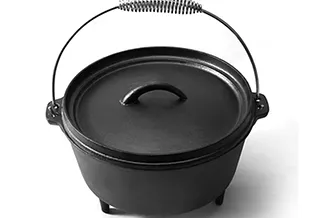
Exploring Various Types of Cast Iron Skillets and Their Unique Features
Different Types of Cast Iron Skillets
Cast iron skillets are kitchen staples known for their exceptional durability, excellent heat retention, and versatility. They come in various types, each suited for specific cooking needs and styles. If you’re considering adding a cast iron skillet to your kitchen arsenal, it’s essential to understand the different types available. This guide will explore the various cast iron skillets, their characteristics, and their ideal uses.
1. Traditional Cast Iron Skillets
Traditional cast iron skillets are the most commonly recognized type. These skillets feature a rough exterior finish and a smooth cooking surface, which can be seasoned over time to enhance its non-stick qualities. They are incredibly versatile and can be used for frying, baking, sautéing, and even grilling. Their ability to withstand high temperatures makes them perfect for searing meats and baking cornbread or other dishes in the oven.
One of the most notable advantages of traditional cast iron skillets is their durability. If properly maintained, they can last for generations. However, they do require regular maintenance, including seasoning after each use and keeping them dry to prevent rust.
2. Enamel-Coated Cast Iron Skillets
Enamel-coated cast iron skillets offer an alternative to traditional models, featuring a porcelain enamel finish that provides a non-reactive surface ideal for cooking acidic foods like tomatoes or vinegar-based sauces. The enamel coating eliminates the need for seasoning, making them easier to clean and maintain.
The downside to enamel-coated skillets is that they are more susceptible to chipping and scratching, so metal utensils should be avoided. However, they are available in various colors and styles, which makes them attractive for serving dishes directly from the oven to the table.
3. Deep Skillets
Deep skillets, often referred to as chicken fryers, are deeper than traditional skillets and typically come with a lid. Their design allows for versatile cooking methods, including frying and braising. The increased depth enables chefs to prepare larger quantities of food while preventing splatter.
These skillets are perfect for frying chicken, making sauces, and cooking stews. The lid helps retain moisture, which is advantageous in long-cooking recipes. Like traditional skillets, deep skillets need proper maintenance to ensure their longevity, but they offer exceptional cooking performance.
different types of cast iron skillets

Skillets equipped with pouring spouts take functionality a step further. These skillets are designed for ease of use when pouring liquids, making them ideal for tasks like draining grease or transferring sauce. The spouts can be found on either side of the skillet, providing versatility for left-handed or right-handed cooks.
The addition of spouts makes these skillets particularly popular among home cooks who value convenience and efficiency. They are versatile enough for everyday cooking, soups, sauces, and more.
5. Cast Iron Griddle
While not exactly a skillet, cast iron griddles deserve mention due to their unique cooking characteristics. The flat surface is ideal for cooking pancakes, grilling sandwiches, or searing vegetables. They provide an even cooking surface and can often be used on stovetops as well as in the oven.
Some griddles come with ridges that mimic grill lines, allowing for an authentic grilling experience indoors. Just like traditional skillets, cast iron griddles require seasoning and care to prevent rust and maintain their non-stick properties.
6. Pre-seasoned vs. Unseasoned
When purchasing a cast iron skillet, you will likely encounter pre-seasoned and unseasoned options. Pre-seasoned skillets come ready for use, as they have already undergone the seasoning process to create a non-stick surface. Unseasoned skillets offer the opportunity for chefs to initiate their seasoning process, allowing for a personalized seasoning level that fits their culinary style.
Conclusion
Cast iron skillets are indispensable tools in any kitchen, each type offering its unique advantages and uses. Whether you choose a traditional skillet, an enamel-coated version, a deep skillet, or any other type, understanding their characteristics will enhance your cooking experience. With proper care, a cast iron skillet can become a cherished cookware piece that provides exceptional performance for years to come. Next time you reach for a skillet, consider which type best suits your cooking needs and style, and enjoy the countless culinary possibilities that cast iron has to offer!
-
Season Cast Iron Perfectly with GPT-4 Turbo TipsNewsAug.01,2025
-
High Quality Cast Iron Cookware - Baixiang County Zhongda MachineryNewsAug.01,2025
-
Premium Cast Iron Pan: Durable & Perfect HeatNewsAug.01,2025
-
High Quality Kitchen Durable Black Round Cast Iron Cookware Pancake Crepe Pan-Baixiang County Zhongda Machinery Manufacturing Co., Ltd.NewsAug.01,2025
-
Cast Iron Cookware - Baixiang County Zhongda Machinery | Nonstick, Heat ResistanceNewsAug.01,2025
-
High Quality Kitchen Durable Black Round Cast Iron Cookware - Baixiang County Zhongda Machinery | Non-Stick, Heat Retention, DurableNewsJul.31,2025


